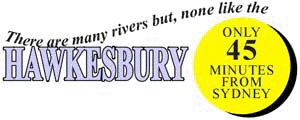|
.

Wildlife
Fish..
Mullet Common in the
river and creeks but almost impossible to catch. Strong flavoured fish.
Bream (min. legal size is 25cm.) Feed on the bottom on
shrimps and small shell fish. Often hooked at night when there is no moonlight.
Flounder White below and dark coloured above these fish
are able to change their colour to match the bottom on which they conceal
themselves to feed on small fish and shellfish.
Flathead (min. legal size is 33cm.) Bottom feeders who often
bury themselves in mud or sand for concealment. They feed on shellfishs and
small fish. They have sharp spikes along the fins. (min. legal size is 33cm.)
Mulloway ( Known as Jewfish min. legal size 38cm.) A member
of the Croaker family, the name derived from their ability to make noise in
& out of the water. Generally occur in schools but large specimens keep to
themselves.
Snapper Colour changes from pink silver to brick red with
blue spots on upper body.
Taylor A swift surface fish, dark blue along the back with
silver belly. Will take lures trolled slowly astern of the boat.
Whiting ( min. legal size 27cm.) Found in shallow water over
sand banks feeding on worms and small shellfish.
Luderick ( Blackfish min. legal size 25cm.) Green or brown
with dark vertical stripes. A school found in shallow waters near reefs and
wharves.
Other Fish and Crustaceans include....
Crabs, Squid, Oysters, Prawns, Eels & Catfish.
Bird
life..
Sea-birds are often abundant in the estuary and lower reaches of
the river and may come quite close to the boat, especially if you are fishing or
cleaning the days catch.
Some of the more common birds include....
Pelican: The largest wing-span of any Australian bird
extending to around 2.5m. The distinctive pouch can hold 10 litres of water and
is used to gather fish.
White Ibis: Commonly seen in flocks on the mudflats near
mangroves. feeding with their beaks prodding the mud for worms. Nests found in
mangroves and rushlands.
Black Cormorant: These yellow beaked common shags can eat
one fifth of their own weight in fish each day. Often seem drying their wings
prior to flight.
Little Pied Cormorant: Black and white with yellow bill.
Like all cormorants it can pursue prey underwater staying submerged for 40
seconds.
White Breasted Sea Eagle: Often seen soaring in pairs
searching and diving for fish and other food including small mammals and birds,
sea-snakes and large crustaceans.
Black Duck: Dark brown with green along each side of breast.
Distinctive dark stripe above and below the eye. Feeds on plants and insects.
Grey Teal: Males have a dark green head, both genders have
the distinctive red eye.
Black Swan: Sometimes seen in broken bay and quiet
tributaries feeding on aquatic plants. Adult pairs mate for life.
Fairy Penguin: Sometimes seen in Broken Bay, Cowan Creek and
Pittwater diving for fish and surfacing to call to others in their group. A
small colony exists on Lyon Island.
Other water birds include....
Egret, Coot, Swamp Hen, Dusky Moorhen, White-faced
Heron, Gannets, Caspian & Gull-billed Terns
Land Birds are varied and numerous. Some species commonly
found include.....
Rainbow Lorrakeet, King Parrot Eastern & Crimson Rosella,
Kookaburra, Galah, Sulphur Crested Cockatoo, Gang Gang,
Corella, Black Cockatoo, Magpie, Currawong, Satin Bowerbird,
Liar Birds, Brush Turkeys, Owl & Frogmouth Owl and many species of finches
and other small birds.
Animals
and Reptiles...
Many varieties of native animals and reptiles are found in the
surrounding national parks.
Common snakes include..... Brown, Black, Red
Belly Black, Carpet, Death Adder, Yellow Belly Black & Green Tree Snake.
Lizards include.... Blue Tongue, Skinks & Goanna
Frogs include.... Red Crowned Toadlet, Green & Golden
Bell Frog
Animals include.... Brush-tailed Possum, Ringtail
Possum, Wallaby, Koala, Wombats, Banbicoots,
Wallaroos, Tiger Quoll, Squirrel Glider as
well as various Bat species.

|